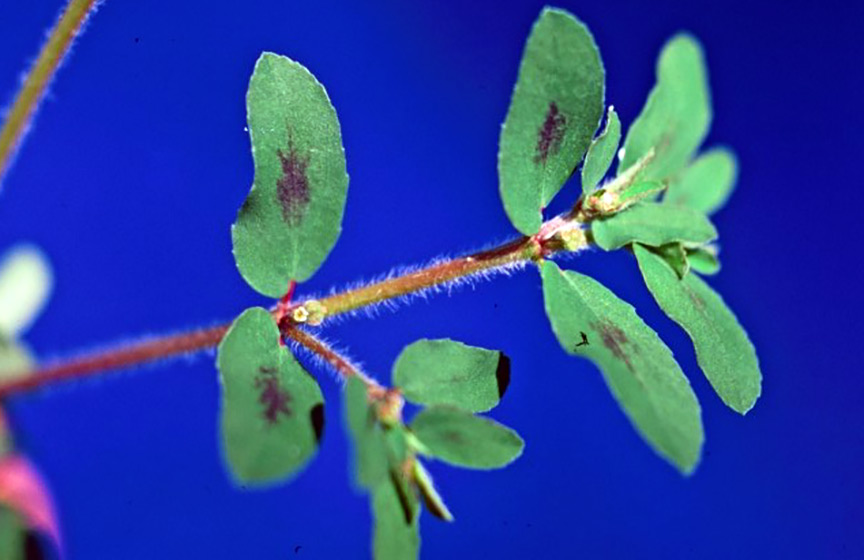Spotted Spurge
(Chamaesyce maculata; Synonym: Euphorbia maculata)
Description
Spotted spurge (Figure 1) is a prostrate summer annual, native to the United States. Sometimes called spotted sand mat, this weed makes its home in sidewalk cracks, roadsides, gardens, and in thinning or drought-stressed lawns. It requires little more than heat, light, water, and a bit of soil to germinate, though it is not very competitive in good growing conditions. The presence of spotted spurge can be a good indicator of an underlying problem, such as soil compaction or drought stress. It likes warm, consistent air temperatures above 75°F, so you’re unlikely to see this weed in the spring.


at a glance
- Spotted spurge can be distinguished from similar prostrate weeds by its leaf spots (usually), milky white sap, and fine-haired stems.
- Though it can germinate at temperatures as low as 60°F, the presence of spotted spurge isn’t problematic until temperatures warm to above 75°F.
- While easy to kill, prevention and persistence are fundamental to its extended control.
Individual plants lay mostly flat against the soil surface and spread outward from a central growing point above a taproot. The stems do not root at the nodes. When stems are broken or injured, they exude a milky white sap (Figure 2) that is an eye and skin irritant. Spotted spurge is also toxic to sheep.


Small, oblong leaves grow opposite on a stem covered with fine hairs. Leaves usually have an irregular, maroon-to-purple spot near the center (Figure 3), a trait that inspired its common name. Small, white-to-pink flowers appear in summer and continue through early fall. The weed may flower within three to four weeks after emerging in midsummer. Viable seeds can be produced about two weeks after flowering.
Integrated Pest Management (IPM) Options
- Prevention. Stop seed production through the elimination of plants before they flower. Because seeds require light to germinate, a minimum of two inches of organic mulch (or a synthetic mulch) is an effective preventive in gardens and ornamental beds. Depending on the source, irrigation water transports weed seeds. Fine screens, like those used in drip and microirrigation filter out weed seeds.
- Mechanical. Wear gloves when handling spotted spurge. Cut the taproot through tillage or hoeing. Hand pulling is effective but mature plants commonly break, leaving part of the crown, which allows spotted spurge to resprout. Following removal, dispose of plants with flowers to avoid spreading seeds. Mowing is ineffective.
- Cultural.
Lawn: Maintain healthy, competitive turf through proper watering and fertilization. Aerate to reduce compaction. Restrict irrigation to only those areas where you want turfgrass coverage.
Garden: Drip and microirrigation are valuable weed management tools in garden and ornamental beds because irrigation can be targeted only to desirable plants. Soil solarization effectively kills spotted spurge and its seeds. - Biological. None known.
- Chemical. Preemergent herbicides containing trifluralin (Treflan, Preen), dithiopyr (Dimension), pendimethalin (Pendulum), and oryzalin (Surflan) are effective tools. They must be applied prior to germination. Retreatment may be necessary as spotted spurge will germinate throughout summer and early fall. Postemergence herbicides are also valuable. Glyphosate (Roundup, Killzall, others) provides nonselective control. Products containing 2,4-D/dicamba combinations (various) can be used to control spotted spurge in lawns. It is always easier to control weeds when they are younger so be vigilant and notice weeds when they are small. It is important to note that some herbicides have temperature maximums, above which they cannot be applied. With spotted spurge comes warm weather and greater risk that herbicides will volatize and damage nontarget plants. The herbicide 2,4-D has both ester and amine formulations. Amines are better than esters in warm temperatures but are still not foolproof. Take care when using herbicides near nontarget plants and observe plant back restrictions. Always read and follow herbicide label directions.
Further Reading
Landschoot, P., T. Abbey, and T. Delvalle. 2020. PennState Extension. “Lawn and Turfgrass Weeds: Spotted Spurge - Chamaescye Maculata L.” https://extension.psu.edu/lawn-and-turfgrass-weeds-spotted-spurge-chamaesyce-maculata-l.
Mahr, S. n.d. Wisconsin Horticulture, Division of Extension. “Spotted Spurge, Chamaesyce (=Euphorbia) maculata.” https://wimastergardener.org/article/spotted-spurge-chamaesyce-euphorbia-maculata/.
Molinar, R.H., D.W. Cudney, C.L. Elmore, and A. Sanders. 2009 (revised). University of California Agriculture and Natural Resources Statewide Integrated Pest Management Program. “Pests in Gardens and Landscapes: Spotted Spurge and Other Spurges.” http://ipm.ucanr.edu/PMG/PESTNOTES/pn7445.html.
NC State Extension. n.d. North Carolina Extension Gardener Plant Toolbox. “Euphorbia maculata.” https://plants.ces.ncsu.edu/plants/euphorbia-maculata/.
Peacock, C. n.d. TurfFiles (NC State Extension). “Spotted Spurge.” https://www.turffiles.ncsu.edu/weeds-in-turf/spotted-spurge/.
About the Authors
Bracken Henderson — University of Idaho Extension Educator, Franklin County
Ron Patterson — University of Idaho Extension Educator, Bonneville County
Disclaimer
ALWAYS read and follow the instructions printed on the pesticide label. The pesticide recommendations in this UI publication do not substitute for instructions on the label. Pesticide laws and labels change frequently and may have changed since this publication was written. Some pesticides may have been withdrawn or had certain uses prohibited. Use pesticides with care. Do not use a pesticide unless the specific plant, animal, or other application site is specifically listed on the label. Store pesticides in their original containers and keep them out of the reach of children, pets, and livestock.
Trade Names — To simplify information, trade names have been used. No endorsement of named products is intended nor is criticism implied of similar products not mentioned.
Groundwater — To protect groundwater, when there is a choice of pesticides, the applicator should use the product least likely to leach.
BUL 998 | Published June 2021 | © 2022 by the University of Idaho










